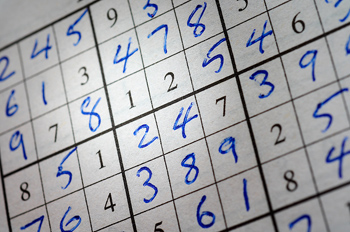How to Play Sudoku
Sudoku is a number puzzle game played all over the world. You can play in newspapers, magazines, online or even in special books just for sudoku puzzles. Even though it is classified as a number game, it requires no mathematical skills. However, a basic knowledge of sudoku is required in order to form proper strategies and be successful in the play of the game. Without knowing the basics of sudoku, looking at this popular puzzle’s layout can be rather confusing.
Sudoku Rules
To understand sudoku rules first you need to understand its board. The game board is a nine by nine grid of blank squares divided up into nine 3×3 smaller grids. These tiny, individual squares need to be filled in with every number ranging from one to nine. Puzzles will start with a select amount of numbers already filled in for you. These are numbers which cannot be changed. However, to complete the puzzle, you must fill in every empty square with the proper number.
What makes the game a puzzle is that you cannot use the same number twice in the same column, row or 3×3 grid. So, you must use strategy and patience to fill these numbers in and solve the puzzle. For more information on the rules of sudoku keep reading below.
Sudoku Pre-filled Numbers
In beginner puzzles, there are already a great deal of numbers filled in for you. In fact, the puzzle maker will provide you with about 80% of the 81 numbers needed to complete the puzzle. In more advanced puzzles, they may give you as few as 10%. This makes the puzzle much harder to solve than you might initially think.
Sudoku Strategy – Getting Started

How to Play Sudoku
To get started with basic sudoku strategy, pencil in all of the numbers that you know for sure. An easy way to know which numbers are certain is by looking at all of the rows first and seeing which rows have eight numbers pre filled in for you. You can then put the remaining number in the correct box. Do the same thing with the columns and small grids. For example, if one column already has the numbers 3, 6, 4, 5, 8, 1, 2 and 9 you can determine that the only possible remaining number is a seven. As each row and column must also contain all nine numbers, using the pre-filled numbers to work through each row, column and grid can be your best basic strategy.
Search through the puzzle and very lightly pencil in all of the possible numbers that could go in each box (you will have to write very small). So, using another example, the square you are looking at is in a small grid, row and column with the numbers 1-2-3-5-7-9. Based on this knowledge, you can determine that the example box must be either a 4, 6, or an 8. Write those three numbers in the box and move on to the next. This process may take a little extra time at first. However, as you gain more experience solving sudoku puzzles, you will get much better at filling in possible numbers on the fly.
Finishing a Sudoku Puzzle
Go back through the entire grid and start eliminating numbers that have definitely been ruled out as possibilities. This comes from looking at other square’s possibilities and seeing which numbers do not match up. For instance, by looking at which grids, rows and columns have the same numbers, you can begin eliminating numbers from your possibility squares. After you have eliminated enough numbers from each of your grids, you can begin to deduce which numbers need to be placed in which grid to complete the puzzle.
Start looking for matching pairs. For example, in the same row, you have two squares with seven and two as possibilities. There is also a third square with a seven, two and three as possibilities. The correct answer for the third square must be a three and you must go back and work on what the first two squares’ answers must be.
